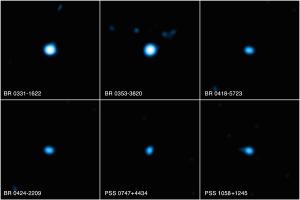Blog
Foamy Evidence
1 June 2015
 NASA/Fermi
NASA/FermiModern cosmology is dominated by two fundamental theories: general relativity, which describes the structure of space and time as manifold that interacts with mass/energy (aka gravity), and quantum theory, which describes the fundamental interactions of protons, electrons, light, etc. (aka quanta). Both models are strongly supported by experimental and observational evidence. The problem is that each theory makes fundamental assumptions about the way the universe works, and they contradict each other at a basic level. This isn’t a problem if you are interested in things on a large scale, such as planets and galaxies (general relativity), or things on a small scale such as nuclear fusion (quantum theory). The contradiction arises when you want to understand objects that are both very dense and interact at high energies, such as black hole interiors, the big bang, etc. So one of the challenges of modern cosmology is to develop a unified theory of quantum gravity, which would combine the predictions of general relativity and quantum theory in a consistent way.
There are lots of approaches to quantum gravity, including string theory and loop quantum gravity, that try to unify these two models, but one of the big challenges is that many of their predictions are difficult if not impossible to verify. But new observations of distant quasars has put some observational constraints on the type of unified model the universe might allow.1
The research focuses on a property common to most unified theory approaches, known as quantum foam. The idea behind quantum foam is that at a fundamental level the quantum aspect of things dominates. This means that on a small enough scale, the precise nature of space and time itself breaks down into a nebulous flurry of quantum fluctuations or quantum foam. In this approach the structure of space and time we see around us is a macroscopic approximation arising out of this foam, just as a table appears solid when in fact it is a dynamic interaction of atoms and molecules. The scale at which the foamy nature of spacetime becomes evident is known as the Planck scale, which is about 10 billionths of the width of a proton. That’s far too small for us to probe directly.
But it turns out that this quantum foam (assuming it exists) should interact very slightly with light. Basically, a photon traveling through spacetime has a tiny chance of interacting with the quantum foam in such a way that its wavelength and direction could be changed. The chances of such an interaction is so small as to almost be zero, but over a billion light year journey it would have a measurable effect. Depending on the quantum foam modal, distant light could appear blurred at certain wavelengths so that our view of distant quasars would become too blurry to be observed.
Based upon observations of distant quasars, the team found no evidence of any quantum foam blurring. Given the constraints of their observations, this means that spacetime is completely smooth down to a scale of at least a thousandth of the width of a proton. This is actually precise enough to eliminate some quantum foam models. In particular, it eliminates one popular model known as the holographic model. As the authors point out, while the holographic model is a popular model relying upon the holographic principle, this research doesn’t invalidate the holographic principle itself.
So to the limits of observation, there is no evidence for a quantum foam. Whether it exists but has more subtle effects is something that will require further research.
Perlman, Eric S., et al. “New constraints on quantum gravity from x-ray and gamma-ray observations.” The Astrophysical Journal 805.1 (2015): 10. ↩︎